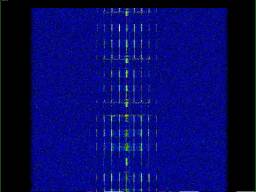Traditionally, a new telescope experiences 'first light' when it is first turned to the sky. The Argus array saw first light nearly three years ago when Steve Ellingson succeeded in detecting orbiting satellites with the eight element array put together to develop software for beam-forming.
Twenty four elements were hurriedly assembled in anticipation of the June 2003 IEEE International Antennas and Propagation Symposium held in Columbus. This array went on line just in time for the open house held for that meeting, giving a convincing display of satellite observation. The antenna boxes for this demonstration held together only a few months. Inadequate finish coats of paint allowed water into the composition wood which warped and started to fall apart. It was at this point the decision was drawn to attempt an open construction for the antenna elements.
So far, the open construction has proven to work fully as well as the box enclosures and seems to offer a more maintenance free situation. In addition, Chief Observer Russ Childers has accomplished several remarkable landmarks in getting the system into a full-time operating mode.
 His first breakthrough came with the observation of the GOES-12 (Geostationary Operational Environmental Satellite) as a calibrating source for the array. By using it as a strong point source he has developed a way to minimize sidelobes generated by the multiple elements in the array. Furthermore, he is able to use the satellite to generate a beam in its direction and by tuning to a nearby frequency observe the sky passing behind the satellite in a scanning mode similar to the scheme used at Big Ear with the fixed praboloid observing along the meridian.
His first breakthrough came with the observation of the GOES-12 (Geostationary Operational Environmental Satellite) as a calibrating source for the array. By using it as a strong point source he has developed a way to minimize sidelobes generated by the multiple elements in the array. Furthermore, he is able to use the satellite to generate a beam in its direction and by tuning to a nearby frequency observe the sky passing behind the satellite in a scanning mode similar to the scheme used at Big Ear with the fixed praboloid observing along the meridian.
During these early calibration experiments Russ observed a number of transient narrow-band signals from passing satellites. These show up readily on the waterfall display of the real time observations both in the observing room and at remote sites. [See the waterfall display of GOES-12 to the left. Click on it for a larger image.]
Another remarkable achievement came early summer of 2004 when the array tracked the sun as it moved from about the meridian till it set in the west. Even though the sun is about 1000 times as strong as the strongest discrete sources in the sky, it is the first truly astronomical source detected by the Argus array.
 Just this past week (mid-February) Russ was able to observe interference fringes as the sun moved westward across the sky. This was accomplished using two of the array elements separated by a few meters in an east-west orientation. The accompanying figure is a plot of these fringes. The horizontal scale is time (24 hours long); the vertical scale is intensity output of the combined elements. [Click on the graphic to see a larger version.] Below is Russ' technical description of the graphic.
Just this past week (mid-February) Russ was able to observe interference fringes as the sun moved westward across the sky. This was accomplished using two of the array elements separated by a few meters in an east-west orientation. The accompanying figure is a plot of these fringes. The horizontal scale is time (24 hours long); the vertical scale is intensity output of the combined elements. [Click on the graphic to see a larger version.] Below is Russ' technical description of the graphic.
"The sun as seen by Argus on February 18, 2005. This image was generated in "interferometry" mode, using two elements approximately 3 meters apart, roughly on an east-west line. Data was generated by multiplying each elements' I-value and summing, and multiplying each elements' Q-value and summing. A 400-acquisition moving window convolution was done over the entire 24-hour set of acquisitions, resulting in a "480-second" integration time. The x-axis is the UTC time; the y-axis is the sum of correlations centered on the 400-acquisition window. Note the interferometric "fringes" while the sun is above the horizon. Fainter fringes might be seen when the sun is below the horizon, perhaps caused by the Cas A supernova. Receiver center frequency is 1692.030 MHz; bandwidth is 70 kHz; each acquisition takes 0.2 seconds; there are 16384 samples per acquisition; time between acquisitions is 1.2 seconds."
[Waterfall display of GOES and graphic of fringes courtesy of Russ Childers.]
![[NAAPO Logo]](../../NAAPOsm.jpg)
![[NAAPO Logo]](../../NAAPOsm.jpg)